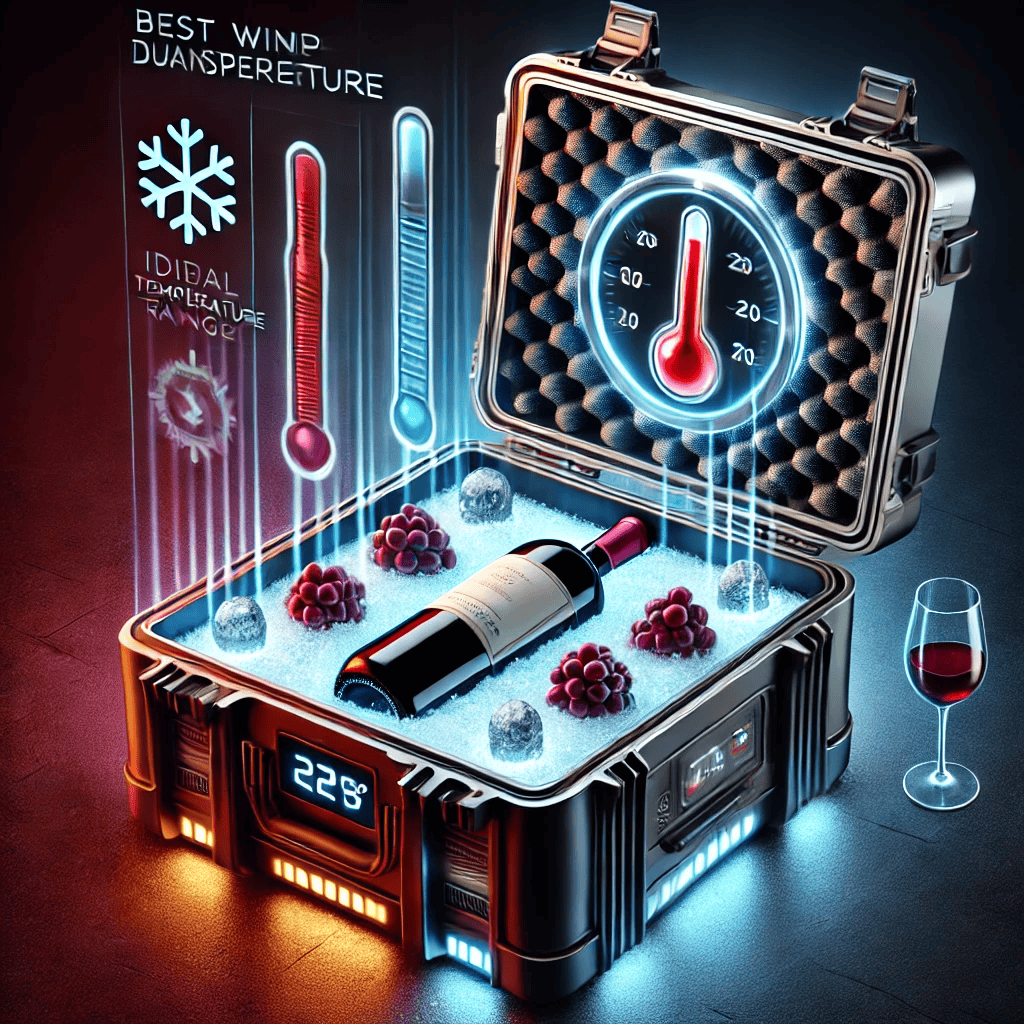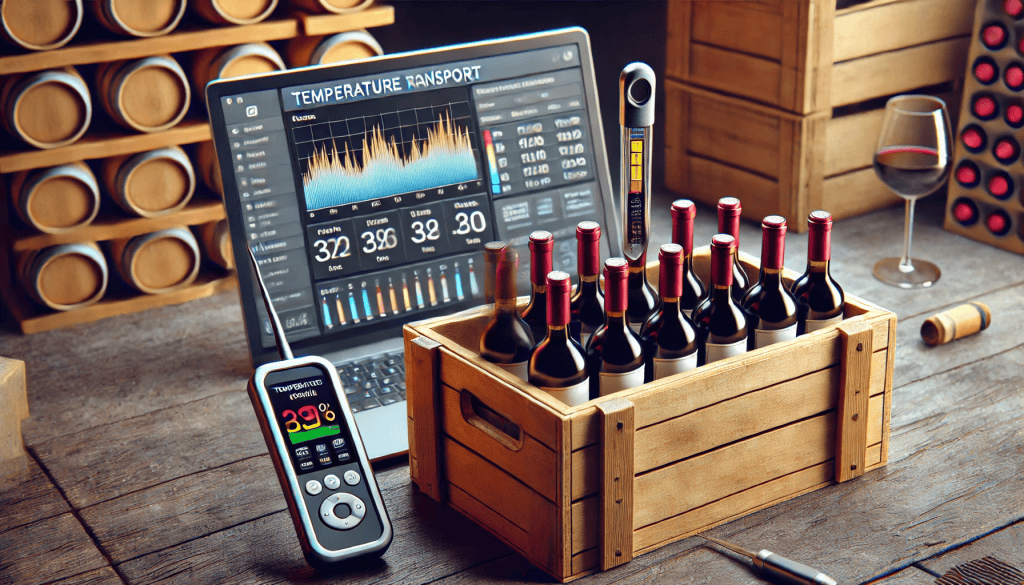Picture this: You’ve just invested in a case of exquisite Bordeaux, eagerly awaiting its arrival. But as you uncork the first bottle, something’s off. The culprit? Temperature fluctuations during transport!
Did you know that a staggering 20% of wine shipments experience temperature-related issues during transit? In this comprehensive guide, we’ll explore the fascinating world of wine temperature during transport and why it’s absolutely critical for preserving the quality of your favorite vintages.
Get ready to become a savvy wine shipper – your taste buds will thank you!
Welcome to Didi Somm and Cheers!
Important Notice: The information in this article is for general and public information purposes only. It solely reflects Didi Somm’s or his Staff’s opinion, and no responsibility can be assumed for errors or omissions in the service’s contents. For details, please check the Disclaimer at the bottom of the homepage.

Key Takeaways
- Temperature fluctuations can significantly impact wine quality during transport
- The ideal temperature range for wine transport is 55-59°F (13-15°C)
- Extreme heat and cold can cause irreversible damage to wine
- Proper packaging and temperature-controlled shipping methods are essential
- Monitoring and tracking tools can help ensure safe wine transportation
The Science Behind Wine Temperature Sensitivity
Let me tell you, I learned about wine temperature sensitivity the hard way. Picture the following situation: I’m hosting my first fancy dinner party, and I decide to impress everyone with a pricey Bordeaux. I cranked up the heat in my apartment to make it cozy, but boy was that a mistake! When I poured the wine, it tasted… off. Turns out, I’d accidentally sped up all those chemical reactions in the bottle.
Here’s the deal: heat is like a turbo button for wine aging. Those flavor compounds and aromas we love? They’re delicate little things. Too much heat, and they go haywire. It’s wild how temperature affects different wines, too. My robust Cabernet? It held up okay. But my poor Pinot Noir? It was a hot mess, literally.
And don’t get me started on oxidation! It’s like letting your wine sunbathe – not a good look. I’ve since learned that keeping wine cool isn’t just about preserving flavor, it’s about slowing down that pesky oxidation process. Trust me, your taste buds will thank you for keeping things chill. Now, I treat my wines like temperamental divas – they get the perfect conditions, or they throw a fit in my glass!

Optimal Temperature Range for Wine Transport
Alright, let’s talk about the Goldilocks zone for wine transport – not too hot, not too cold, but “juuust” right. After my fair share of wine shipping fiascos, I’ve nailed down the sweet spot: 55-59°F (13-15°C). It’s like a cozy sweater for your vino, keeping it happy and stable.
But here’s the kicker: not all wines play by the same rules. I once shipped a dessert wine, thinking it’d be fine at regular temps. Big mistake! Those sugar bombs actually prefer it a tad cooler. And don’t even get me started on my attempt to ship Port in the middle of summer. Let’s just say it arrived… spirited.
Now, here’s a million-dollar question: what’s worse, temperature fluctuations or constant high temps? From my experience (and a few tearful tastings), it’s the roller coaster rides that really mess with your wine. I once tracked a shipment that went from freezing to boiling and back again. The result? Wine that tasted like it had an “identity crisis.
Oh, and let me introduce you to a term that still gives me nightmares: “temperature abuse.” It’s like sending your wine to boot camp, but instead of coming back stronger, it returns a shell of its former self. Trust me, you want to avoid this at all costs. Keep it steady, keep it cool, and your wine will thank you with every sip!
Dangers of Extreme Temperatures During Wine Transport
Let me tell you about the time I tried to save a buck on shipping and ended up with a case of very expensive vinegar. It was the height of summer, and I thought, “How bad could it be?” Well, let me tell you, when temperatures soar above 70°F (21°C), wine doesn’t just get warm – it gets wonky.
High heat is like putting your wine in a pressure cooker. It ages faster than a Hollywood starlet, and not in a good way. The flavors get all muddled, the alcohol can start to separate, and sometimes, the cork even decides to make a break for it. Trust me, nothing says “party foul” like opening a bottle and finding the cork halfway out.
But it’s not just the heat you gotta watch out for. I once had a winter shipment arrive with what I can only describe as wine slushies. Freezing temperatures can cause the water in wine to expand, pushing out the cork or even cracking the bottle. And let me tell you, thawed wine is about as appetizing as it sounds.
The real kicker? Sometimes, you can’t even tell there’s a problem until you pop the cork. I’ve had bottles that looked perfect but tasted like they’d been through a war. Heat damage can turn your prized Pinot into something that tastes more like cough syrup while freezing can leave you with a grainy, off-tasting mess. Take it from someone who’s learned the hard way – when it comes to wine transport, temperature matters. A lot.
Best Practices for Temperature-Controlled Wine Shipping
Okay, folks, gather ’round for a tale of triumph over temperature tyranny! After my fair share of wine shipping disasters, I’ve become a bit of a temperature control ninja. Let me spill the tea (or should I say, wine?) on keeping your precious bottles safe and sound during their journey.
First things first: shipping containers. These aren’t your average cardboard boxes, oh no. We’re talking insulated warriors, ready to battle the elements. I swear by these styrofoam soldiers with their snug bottle inserts. They’ve saved my Syrah more times than I can count!

Now, let’s chat about passive vs. active temperature control. Passive is like bundling up your wine in a cozy blanket – think ice packs and insulation. Active? That’s like giving your wine its own personal AC unit. I used to think passive was enough, but after one too many close calls, I’m team active all the way for those extra-special bottles.
Insulation is key, people! I once wrapped a bottle in bubble wrap, thinking I was so clever. Spoiler alert: bubble wrap does bupkis for temperature control. Now I use proper insulating materials that would make an eskimo jealous. And don’t forget seasonal strategies! Summer shipments get extra ice packs, while winter warriors get heat packs to fend off Jack Frost.
To conclude, my wine-loving friends: a little extra care in packaging can mean the difference between popping open a perfect bottle and crying over grape juice gone wrong. Trust me, your future self (and your taste buds) will thank you!
Monitoring and Tracking Wine Temperature During Transit
Let me tell you, folks, I used to ship wine with all the confidence of a tightrope walker in a hurricane. That is, until I discovered the magic of temperature logging devices. These little gadgets are like having a tiny, vigilant sommelier watching over your wine 24/7.
I remember the first time I used one. I felt like a secret agent, slipping this high-tech gizmo into the package. When my wine arrived, I eagerly checked the logs and… holy merlot! The temperature had been doing the cha-cha all across the country. It was eye-opening, to say the least.
Now, if you really want to get fancy (and believe me, I do), there are real-time monitoring systems that let you track your wine’s temperature journey like it’s a reality show. “Oh no, Chateau Margaux hit a heat wave in Texas! The suspense is killing me!”
But here’s the thing: all that data is useless if you don’t know how to interpret it. I spent hours poring over temperature logs, feeling like a wine detective. Pro tip: look for any major spikes or dips. Those are your red flags. And don’t forget to use this info to improve your shipping game. I’ve tweaked my routes, changed carriers, and even adjusted packaging based on these temperature tales.
Trust me, once you start monitoring your wine’s temperature during transit, you’ll wonder how you ever shipped without it. It’s like having x-ray vision into your wine’s journey. And let’s be honest, who doesn’t want to be a wine superhero?

Legal and Insurance Considerations for Wine Transport
Alright, buckle up, wine lovers, ’cause we’re about to dive into the thrilling world of wine shipping legalities. (I know, I know, try to contain your excitement!) After a few, shall we say, “educational” experiences with the law, I’ve learned a thing or two about keeping things above board.
Did you know there are actual temperature requirements in wine shipping regulations? I didn’t, until a particularly stern customs officer enlightened me. Turns out, you can’t just toss a bottle in a box and hope for the best. Who knew?
Now, let’s talk liability. Picture this: you ship a case of premium vino, only to have it arrive as expensive vinegar. Who’s on the hook? In my early days, I learned the hard way that without proper precautions, it could be yours truly. Nowadays, I dot my i’s and cross my t’s when it comes to temperature control.
Insurance for temperature-sensitive wine shipments? It’s a thing, and trust me, it’s worth every penny. I once skipped insurance on a pricey Bordeaux shipment. Long story short, it arrived “cooked,” and I was left crying into my empty wallet. Never. Again.
Documentation is key, folks. I keep records like a squirrel hoarding nuts for winter. Temperature logs, shipping manifests, you name it. It might seem like overkill, but the one time you need it for a claim, you’ll be thanking your past self. Learn from my mistakes: when it comes to wine shipping, better safe than sorry (and thirsty)!
Our Tip: Please check the following specialized US Wine Insurers, InsureMyWine or HORTEN, for details and a quotation.

Emerging Technologies in Wine Temperature Management
Hold onto your corkscrews, folks, because the world of wine temperature management is getting a high-tech makeover! I remember when I thought a styrofoam cooler was cutting-edge. Oh, how times have changed.
Let’s talk smart packaging. We’re not just talking insulation here – we’re talking packaging that thinks for itself. I recently shipped a bottle in a container that could actually regulate its own temperature. It was like sending my wine on vacation with its own personal climate control. Talk about traveling in style!
But wait, it gets better. AI and machine learning are entering the wine world, and it’s not just for show. These brainy systems can predict temperature issues before they happen. It’s like having a psychic for your Pinot! I once used an AI-powered shipping service that rerouted my wine to avoid a heatwave. Mind. Blown.
Now, here’s a buzzword for you: blockchain. No, it’s not a new way to cork bottles. It’s actually being used to track wine temperature from vineyard to glass. I geeked out hard when I first saw this in action. Every temperature fluctuation, every stop on the journey, all recorded and unalterable. It’s like a family tree for your wine’s travels!
And for my fellow tree-huggers out there, sustainable temperature control is becoming a thing. I’m talking solar-powered cooling, eco-friendly insulation, and the works. It’s enough to make you feel good about ordering that extra case. After all, you’re saving the planet, one perfectly chilled bottle at a time!
The future of wine shipping is here, and let me tell you, it’s cooler than a crisp Sauvignon Blanc on a summer day. Cheers to technology keeping our wines happy and our palates even happier!

FAQ – Wine Temperature During Transport
- Q: What is the ideal temperature for transporting wine? A: The ideal temperature range for transporting most wines is between 55-59°F (13-15°C).
- Q: Can wine recover from temperature damage during transport? A: Minor temperature fluctuations may not cause permanent damage, but extreme or prolonged temperature exposure can irreversibly affect wine quality.
- Q: How does heat affect wine during transport? A: Heat can accelerate aging, cause expansion leading to cork push-out, and alter flavor compounds, potentially ruining the wine.
- Q: Is it safe to ship wine in winter? A: Yes, but precautions must be taken to prevent freezing, which can cause expansion and cork damage.
- Q: What’s the best packaging for temperature-controlled wine shipping? A: Insulated containers with temperature-regulating materials like phase change materials or gel packs are highly effective.
- Q: How long can wine withstand suboptimal temperatures during transport? A: While brief exposure may not be harmful, prolonged exposure (over 24 hours) to temperatures outside the ideal range can impact wine quality.
- Q: Are some wines more sensitive to temperature fluctuations than others? A: Yes, delicate wines like Pinot Noir and aged wines are generally more susceptible to temperature damage than robust young reds.
- Q: How can I tell if my wine has been damaged by temperature during transport? A: Signs include pushed-out corks, leakage, unusual sediment, and off flavors or aromas when tasting.
- Q: Is it better to ship wine in summer or winter? A: Spring and fall are generally the safest seasons, but with proper precautions, wine can be shipped year-round.
- Q: What’s the difference between passive and active temperature control in wine shipping? A: Passive control uses insulation and cold packs, while active control involves refrigeration units or temperature-controlled vehicles.
- Q: How accurate are temperature logging devices for wine shipments? A: Modern devices can be highly accurate, with many offering precision within ±0.5°C.
- Q: Can I use regular shipping services to transport wine? A: It’s risky. Specialized wine shipping services or temperature-controlled options are strongly recommended. Pro Tip: Check TWM / The Wine Mover
- Q: What’s the impact of temperature fluctuations on cork condition? A: Fluctuations can cause the cork to expand and contract, potentially compromising its seal and allowing oxygen to enter.
- Q: Are there any wines that are more resistant to temperature changes during transport? A: Generally, fortified wines like Port are more resilient due to their higher alcohol content.
- Q: How does altitude affect wine during air transport? A: Higher altitudes can lead to lower air pressure, potentially causing corks to push out or bottles to leak.
Conclusion
As we’ve uncorked the mysteries of wine temperature during transport, it’s clear that this often-overlooked aspect of wine logistics is absolutely crucial for preserving the quality and integrity of our beloved vintages. From the science behind temperature sensitivity to cutting-edge monitoring technologies, we’ve covered all the bases to ensure your wine arrives in perfect condition.
To summarize, whether you’re a casual enthusiast or a seasoned collector, understanding and controlling temperature during transport is the key to unlocking the full potential of every bottle. So, the next time you’re shipping or receiving wine, keep these insights in mind – your taste buds will raise a glass in gratitude!
Cheers to temperature-savvy wine transport and the exquisite experiences it preserves!
For your reference, the latest articles by Didi Somm include:
- Transform Your Wine Cellar: Creating the Ultimate Tasting Room in 2024
- EuroCave Vs Vintec Wine Cellar Systems: Compare And Get The Best One For You
- Wine Cellar Lighting Ideas: Create Your Unique Style And Ambiance
- Smart Wine Cellar Monitors: Best Performers Selected For You
- Expert Guide to Portable Wine Storage: All You Need to Know
- 10 Best Tips For Transporting Wine Safely: Your Expert Guide
Important Notice: The information in this article is for general and public information purposes only. It solely reflects Didi Somm’s or his Staff’s opinion, and no responsibility can be assumed for errors or omissions in the service’s contents. For details, please check the Disclaimer at the bottom of the homepage.


